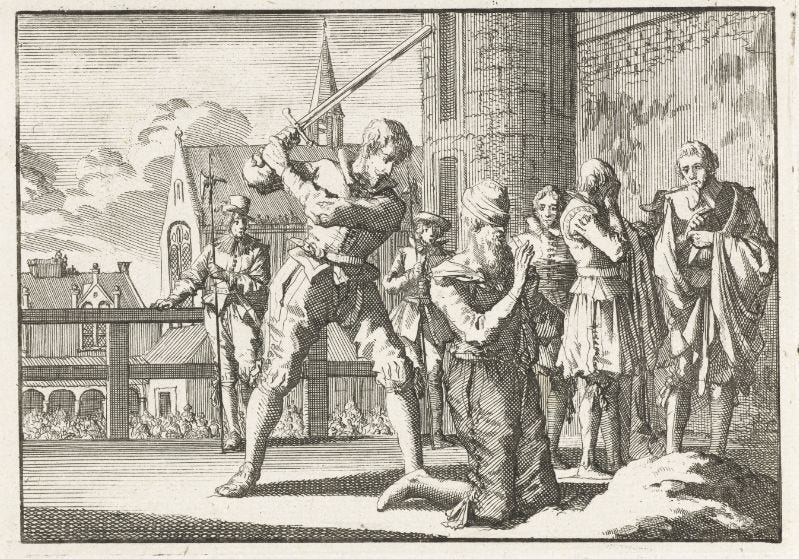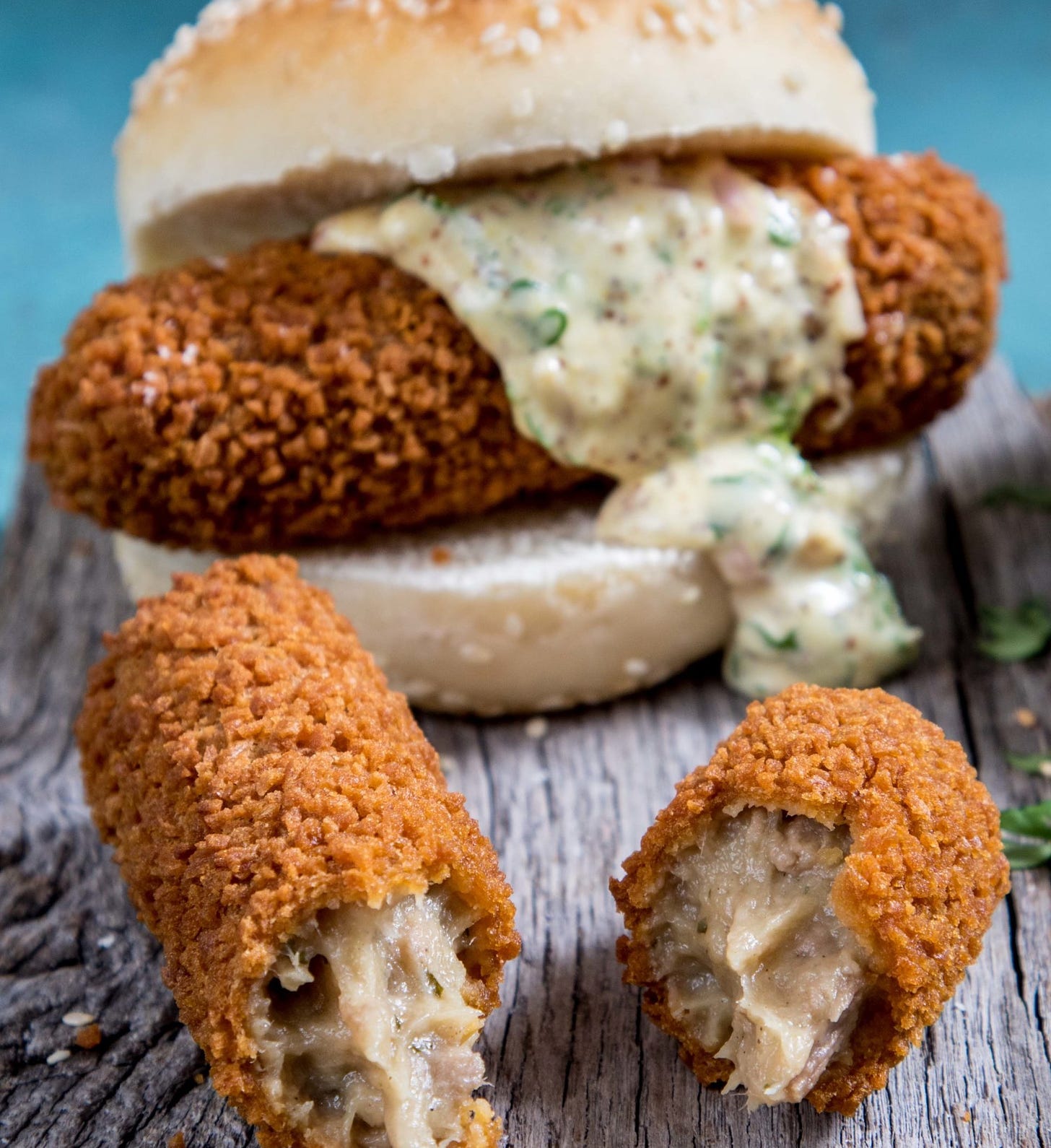Notable Sandwiches #22: Broodje Kroket
From The Netherlands by way of Dr. Freud: Sometimes a sandwich is just a sandwich. But sometimes it's more.
Welcome to the latest installment of Notable Sandwiches, the feature where I, alongside my editor David Swanson, stumble through the demented and mysterious document that is Wikipedia’s List of Notable Sandwiches, one essay at a time. This week: a Dutch favorite, the broodje kroket.
My first thought upon seeing the broodje kroket, a Dutch fast-food staple, was not a very wholesome one. The pressed-meat cylinder in the bun looked, to me, like a sexual snapshot—coitus en croute. I realize this is part of the appeal, perhaps, of any sausage-in-a-bun type dish, or at least a side effect of any such configuration. Still, something about the crusty dark forcemeat and the droop of the bread and the trickle of mustard left me feeling chagrined at my own mind, and faintly blushing at having to write about it—this ungraceful bite, and my ungraceful thought. The Dutch cannot be blamed for my smutty imagination; the broodje kroket (“croquette bread”) is nothing more or less than, as the Guardian puts it, “log-shaped nuggets of meat ragu, covered in breadcrumbs and deep-fried. The construction of the kroket sandwich basically involves stuffing one or two of these deep-fried snacks into a soft roll or slice of white bread and saucing with spicy mustard.”
Log-shaped stubby meat nuggets—what’s not to love, especially when they’re crammed into a bun one or two at a time, and generously sauced? It’s just a snack. Everything’s fine. My Freudian reaction to this sandwich probably has more to do with the moist effulgence of spring than anything intrinsically sensual about the kroket. There are two main drives, Freud says: sex and death. And while the good doctor has been largely discredited these days, eros and thanatos both retain their pertinence. As it happens, the history of this particular sandwich has much more to do with the latter than the former—entangled as it is in the bloody history of the Netherlands, and it is this history that is the chief source of its obscenity, not any lewd resemblances. According to our chief source, Wikipedia, the broodje kroket is the second most popular snack in all of the Netherlands, just behind the frikandel (“a sort of minced-meat hot dog”). The Dutch love this sandwich like they love cycling, living below sea level, windmills, and downplaying their blood-soaked history of colonialism.
In fact, despite this irreverent and slightly louche introduction, the history of the broodje kroket is intertwined with the brutal history of its homeland. Most of the sandwich’s ingredients are bog-standard European, from the chopped beef to the béchamel to the spicy mustard. Today, the kroket can be filled with almost anything (stir-fried noodles, mashed potato, liver and rice, goulash.) But in the recipe I found, the glaring exception to the European-centric ingredients was the teaspoon or so of kecap manis, sweet soy sauce—the most popular condiment in Indonesia. Kecap manis is popular in the Netherlands because the Dutch East India Company conquered what is now Indonesia four centuries ago, and its parent nation held on to the so-called “Spice Islands” for more than three hundred years. That’s why kecap manis is in the broodje kroket, and other Dutch dishes, like zeeuws spek, a marinated bacon. You can also buy it from online stores that cater to the nostalgia of Dutch expats. The story that brought kecap manis to the streets of Amsterdam and Utrecht is a story of blood and treasure.
Indonesia was subjugated, initially by the Dutch East India Company in 1619 and then, once the bankrupt institution was nationalized, by the Dutch nation in 1800. It was known as the Dutch East Indies until its independence in 1949. Indonesia thus was, for over a century, subject to “company rule”—the dictatorship of a trade consortium, exploited for its natural resources (chiefly spices,) pumped full of opium, its populace enslaved by the thousands for toil in the company’s fields and factories. After 1800, when corporate rule became Dutch rule, the slave trade remained in place de jure until 1860 and in practice, according to a recent analysis by the Dutch National Archives, for decades afterwards. Indonesia consists of some 17,000 islands, and is today inhabited by nearly three hundred million people. It is one of the largest countries in the world. And for three hundred and twenty years its capital was a Dutch outpost of trade and blood, spices and kecap manis, flowing back to the tiny nation of 1.5 million. I’ve biked across Amsterdam’s canals and marveled at their cleanliness, and their loveliness, and the orderly rows of tulips and the tidy, gabled townhouses, and forgot for a minute, or didn’t know back then, that every stone was bought with a dram of someone’s blood, a pinch of pepper, the sap of a rubber tree, a child bought and sold.
The Sword and the Sandwich is a newsletter about deadly serious extremism and equally serious sandwiches. Please consider supporting this work with a paid subscription:
Compared to centuries past, the things we say and don’t say these days are always telling. It’s certainly not that the world is free from corporations anymore, or that they don’t bend governments to their will (or simply shape governments around themselves); privilege just means “private law,” after all, and wealth remains a principal legislative currency. The Gazproms and Raytheons and Facebooks of the world have as much to do with violence as the Dutch East India Company ever did; it’s just that today’s CEOs don’t necessarily have entire armies and armadas, and don’t go around, say, razing capitals to the ground and exiling their princes (as occurred in Batavia, now Jakarta, in 1619) purely because they can, and the people whose cities you’re razing aren’t white.
In 2022, all this is couched under a few extra layers of politesse and at least the appearance of intrigue, although Vincent Bevins’ The Jakarta Method is a pretty excellent look at the more recent hair-raising exploits of Cold War colonialism in Indonesia and elsewhere—the iron fist hits no less hard for the velvet glove. The Dutch East India Company—known by its Dutch acronym, VOC—was founded in 1602 by a formidable man with a forked beard named Johan Van Olderbarnevelt, and for centuries it was more or less an empire in its own right. It also pioneered such things as the vertical integration of supply chains and sell-offs of shares to the public, and is widely considered the direct ancestor of all subsequent multinational corporations. And it ran countries until they bled, and long after.

It’s pretty astounding to consider the breadth of the Dutch Empire, to say nothing of its cruelty. I live in New York City, at one time a Dutch colony in its own right; the Dutch developed strongholds in Brazil, Suriname, Bengal, the Virgin Islands, Ghana, the Cape of Good Hope and elsewhere. They were enthusiastic participants in the transatlantic slave trade, as well as spice-market monopolists in their Asian outposts. But the brutalities of Dutch colonialism in Indonesia, according to the Dutch National Archives, are less well known than its Atlantic cruelties, despite the plethora of documentation around the Dutch East India Company: there are simply too many islands—and too little regard for the lives of those living there—for the records to be reliable. Still, from what we know, VOC soldiery carried out rape, torture and execution on a mass scale, and as late as 1949, under the auspices of the Dutch state, 150,000 Indonesians were killed in their war for independence, the last gasp of the empire from across the long sea.
Complicating all this is the fact that the Low Countries have a proud (and seemingly contradictory) history of openness to the oppressed: the Pilgrims didn’t leave Britain for America, they left for the sanctuary of Holland, as did the Sephardic Jewish refugees fleeing Spain. But this tradition of domestic tolerance clashes with the realities of colonization in the name of pioneering capitalism. In Amsterdam, tourists can visit the Anne Frank House, and then several blocks away, gawk at the shrunken heads at Ripley’s Believe It or Not! Nearby, the Tropenmuseum (the Museum of the Tropics, formerly the Colonial Museum), tells a familiar Netherlandish tale of tolerance braided with oppression, all under one roof. So large is the museum that, during the Nazi occupation in World War II, it housed the headquarters of both the German Grüne Polizei and the Dutch Resistance. After the War, the structure—now named The Indies Institute—not only displayed relics of Indonesian culture, it served as staging ground in the fight against Indonesian independence.
It would be perhaps logical, or intuitive, to say that the brutalities of Dutch colonialism are presently viewed by the populace as a source of shame. They largely are not. A 2020 poll recorded 50% of the Dutch population viewing colonialism as a source of pride, and only 6 percent viewed it as shameful; no Dutch government has ever apologized for the colonization of Indonesia, or atrocities such as the slaughter of the entire native population of the Indonesian island of Banda (because the islanders had long cultivated nutmeg, a key ingredient in béchamel sauce) by VOC officer Jan Pieterszoon Coen. A statue of Coen still proudly stands in his hometown of Hoorn. A people who revel in their ostensibly welcoming nature have a hard time reckoning with a history laced with racism—there remains a glaze of surface tolerance sweetening the Dutch identity.
And kecap manis sweetens all sorts of Dutch dishes. It’s syrupy, full of palm sugar and soy. Indonesia has been independent for seventy-three years now, but it still bears the scars of the centuries, and the meddling of Western empires never really stopped; the mass slaughter of up to a million purported and actual Communists in 1965-66 by a U.S.-backed military government reverberates to this day. They were still finding mass graves in 2017. But the Dutch have their krokets and their tulips, and the U.S. calls itself a bastion of freedom and a giver of freedom. It would take more kecap manis than even the entire country of Indonesia manufactures to sweeten the taste of that.








I love this phrase: "the iron fist hits no less hard for the velvet glove"
What a great read. **"The Dutch love this sandwich like they love cycling, living below sea level, windmills, and downplaying their blood-soaked history of colonialism." **